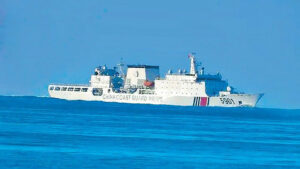Philippines deploys coast guard plane to check Chinese ships near Pangasinan
THE Philippine Coast Guard (PCG) on Sunday said it had deployed an aircraft to check the “illegal presence” of two Chinese vessels 63 kilometers from the coast of Pangasinan province facing the South China Sea in the country’s north. In a statement, the PCG said its Islander aircraft confirmed the presence of the China Coast […]

THE Philippine Coast Guard (PCG) on Sunday said it had deployed an aircraft to check the “illegal presence” of two Chinese vessels 63 kilometers from the coast of Pangasinan province facing the South China Sea in the country’s north.
In a statement, the PCG said its Islander aircraft confirmed the presence of the China Coast Guard (CCG) vessels with bow numbers 3301 and 3104 at 9:30 am on Sunday.
“Notably, the CCG vessels did not respond to the radio challenge issued by the PCG,” it added.
It said two 44-meter PCG vessels — BRP Cabra and BRP Bagacay — were dispatched to Bolinao, Pangasinan, “to address the illegal presence of the China Coast Guard.”
The vessels reinforce the Philippine government’s position against the “normalization of illegal patrols” by China within the Philippines’ exclusive economic zone in the South China Sea.
On Saturday night, the Philippine Coast Guard said BRP Teresa Magbanua had “successfully maneuvered” to drive CCG 3304 further away from the Zambales coastline.
This prompted China to replace CCG 3304 with CCG 5901, China’s “monster” ship, the PCG said.
“The crew aboard BRP Teresa Magbanua demonstrated remarkable courage and resolve, remaining undeterred by the presence of the massive CCG 5901,” it said.
BRP Teresa Magbanua, the Philippines’ biggest coast guard ship, can displace 2,265 tons of water, compared with 12,000 tons for China Coast Guard ship 5901, the largest coast guard cutter in the world.
The PCG said the actions of the Chinese vessels are illegal violate the United Nations Convention on the Law of the Sea (UNCLOS), to which China is a signatory.
“The PCG reaffirms its commitment to the President and the Filipino people, ensuring that our dedicated personnel will continue to protect Filipino fishermen, uphold our maritime rights, enforce international law and work towards the de-escalation of tensions,” it said.
The Philippine Coast Guard last week said its biggest ship had been issuing hourly radio challenges to CCG 3304 near the Zambales coast.
The Philippines has accused China of intimidating Filipino fishermen near Scarborough Shoal and normalizing its “illegal presence” after Beijing sent the monster ship into its exclusive economic zone (EEZ) on Jan. 4.
China, which claims sovereignty over most of the South China Sea, has repeatedly accused Philippine vessels of encroachment on its territory. Bilateral ties are at their worst in years after repeated confrontations and heated diplomatic rows.
A United Nations-backed court in the Hague voided China’s expansive claims in the South China Sea in 2016, as it ruled the shoal is a traditional fishing ground for Filipino, Chinese and Vietnamese fishermen.
Teresa Magbanua replaced the 44-meter vessel BRP Cabra, which arrived at Subic Port on Jan. 28 to unload the body of a Filipino fisherman that it recovered a day earlier.
The PCG on Monday night accused China Coast Guard 3304 of shadowing its ship that was rescuing the fisherman’s fishing boat. It said BRP Cabra navigated through heavy waves to retrieve the body using its crane.
Tensions between the two nations have worsened in the past year, with Manila accusing Beijing last month of using a long-range acoustic device (LRAD) against its vessel near the Zambales coast.
During their 10th consultation, representatives from both sides agreed to continue the conduct of rotation and resupply missions to Second Thomas Shoal and sustain the de-escalation of tensions in the area, the Department of Foreign Affairs said last month.
The Philippines grounded BRP Sierra Madre, a Word War II-era vessel, at the disputed shoal in 1999 to assert its sovereignty. — Kyle Aristophere T. Atienza


















